NAHA-TE
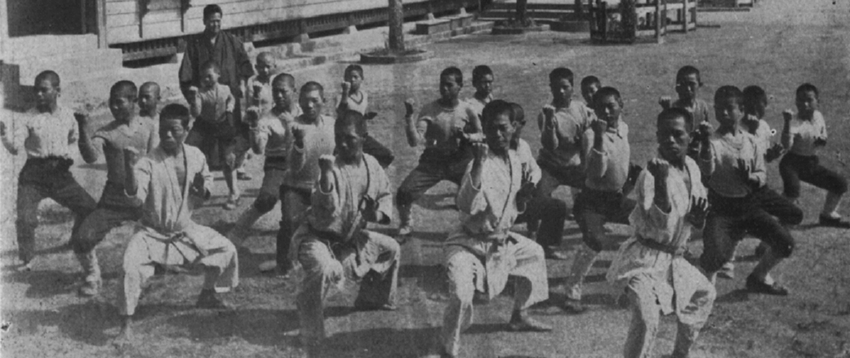
Naha-te (那覇手Okinawan: Naafa-dii) is a pre-World War II term for a type of martial art indigenous to the area around Naha, the old commercial city of the Ryūkyū Kingdom and now the capital city of the island of Okinawa.
Well into the 20th century, the martial arts of Okinawa were generally referred to as te, which is Japanese for „hand”. Te often varied from one town to another, so to distinguish among the various types of te, the word was often prefaced with its area of origin; for example, Naha-te, Shuri-te, or Tomari-te.
Naha-te was primarily based on the Fujian White Crane systems of Southern China, which trickled into Okinawa in the early 19th century through Kumemura (Kuninda), the Chinese suburb of Naha, and continued developing and evolving until being finally formalized by Higaonna Kanryō in the 1880s.
In the first few decades of the 20th century, a number of formal organizations were founded to oversee Okinawan martial arts, and due to their influence, the word karate came to be widely accepted as a generic term for all sorts of Okinawan unarmed martial arts. With the popularity of the term karate, the practice of naming a type of martial art after its area of origin declined. The term Naha-te is no longer in general use.
Naha-Te is the name of the particular type of Okinawan martial art that developed in the port town of Naha, the modern day capital of Okinawa. The martial art that indigenously developed in Okinawa was called Te („Hands”), and the continuous Chinese influences that incorporated Chinese Boxing (Chuan-Fa,
nowadays known as Chinese boxing) were eventually reflected by naming the Okinawan martial arts Tang-ti „Chinese Hand”.
Credited for the early development of Naha-Te is Kanryo Higaonna (1853-1915). Kanryo Higaonna students include Chojun Miyagi (1888-1953), the founder of Goju-ryu. Taken from the Bubishi meaning hard and soft and Kenwa Mabuni (1889-1952), the founder of Shito-ryu. Shito-ryu truly has no translation, but
the first two ideograms from his teacher Itosu=糸, SHI and Higaonna = 東 ,TO, (糸東流). The founder of Goju-ryu was Chojun Miyagi (1888-1953).
He became a disciple of Kanryo Higaonna (1853-1915), the founder of the Naha-te style, when he was 14. He endured harsh ascetic practices and in 1915
went to Fujian Province in China to perfect his skills in the martial arts. He also undertook a lot of research on noted Chinese warriors. As a result, he was
able to take over and organize karate techniques and the principles of the martial arts that he had been taught. He consolidated modern karate do, incorporating effective elements of both athletics and the martial arts in addition to the principles of reason and science.
Chojun Miyagi’s most promising disciple, Jinan Shinzato, gave a demonstration at the ‘All Japan Martial Arts Tournament Offering Congratulations on the Emperor’s Accession’ held in Meiji Jingu Shrine in 1929. Afterwards he was asked what school of karate he belonged to. When he returned home, he told master Miyagi about this and Miyagi decided to choose the name Goju-ryu (the hard-soft style), inspired by one of the ‘Eight Precepts’ of Kempo, written in the Bubishi, and meaning ‘The way embraces both hard and soft, both inhalation and exhalation. The main characteristic of Goju-ryu is the ‘respiration method’ accompanied by vocal exclamations, emphasizing ‘inhaling and exhaling’ and ‘bringing force in and sending force out’.
The Kata of Goju-ryu are broadly divided into: Sanchin (basics), Kaishu-gata (open hand forms), and Heishu-gata (closed hand forms). The traditional Kata passed down from Kanryo Higaonna to the present include: Sanchin, Saifa, Seienchin, Shisochin, Sanseiru, Seipai, Kururunfa, Seisan, and Suparinpei (or Pecchurin). In addition to such traditional Kata, Goju-ryu has added Kokumin Fukyugata, a series of Kata created by Chojun Miyagi for the nationwide popularization of the school Gekisai I, Gekisai II and Tensho-which complete the Kata of Goju-ryu for Tanren.
Important Okinawan masters of Naha-te:Kogusuku Isei,Maezato Ranhō, Arakaki Seishō, Higaonna Kanryō, Miyagi Chōjun, Nakamiya Kenri, Kyoda Jūhatsu, Mabuni Kenwa, Gogen Yamaguchi
Important katas:Sanchin, Saifā, Seienchin, Shisōchin, Seipai, Seisan
The successor styles to Naha-te include Gōjū-ryū, Tōon-ryū (developed by the students of Higaonna Kanryō), Kogusuku-ryū, and others.
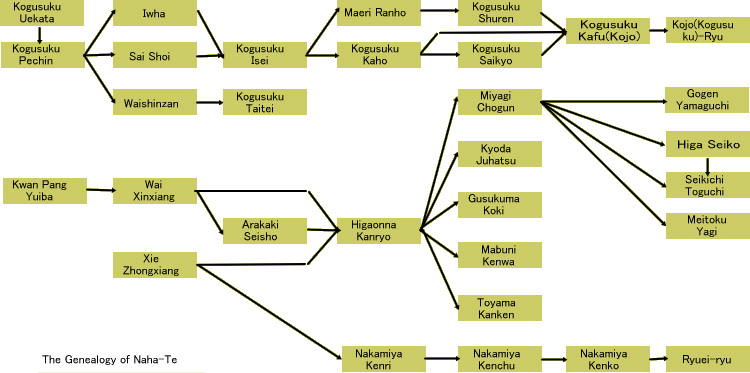
Ryū Ryū Ko (ルールーコウ)
Ryū Ryū Ko (ルールーコウ Rū Rū Kou1852 – 1930), also known as Ryuko, Ryuru Ko, Liu Liu Gung, Liu Liu Ko, To Ru Ko, was a teacher of Fujian White Crane, notable for instructing many of the founders of Okinawan martial arts which later produced Karate. The kata Sanchin, taught in Gōjū-ryū and most other styles of Karate, was originally taught by Ryū Ryū Ko.
Although Ryū Ryū Ko is mostly known from the accounts of his Okinawan students, he is generally identified, based on the research of Tokashiki Iken, as Xie Zhongxiang, born in Changle, Fujian, to a noble family which lost its status in political turmoil of the time. He was one of the first generation masters of Míng hè quán (鳴鶴拳, Whooping Crane Fist), which he either learned from his teacher Kwan Pang Yuiba (who was a student of Fāng Qīniáng, the originator of the first White Crane martial art), or created himself, based on more general White Crane style of his teacher. He had to conceal his name and aristocratic lineage and took on the name Ryu Ryu Ko, under which he worked, making household goods from bamboo and cane. He has been teaching martial arts at his home to a very small group of students, which included Higaonna Kanryō, who stayed with Ryu Ryu Ko from 1867 to 1881. Ryu Ryu Ko expanded his class to an actual public school in 1883, running it with his assistant, Wai Shinzan (Wai Xinxian). It is also said that he had a son named Xie Tsuxiang,Ryu Ryu Ko’s currently living direct descendant is his great-grandson, Xie Wenliang.
Some historians do not agree with Xie Zhongxiang identification, it’s been suggested that Ryu Ryu Ko taught other styles of southern Chinese martial arts, or even that Ryu Ryu Ko was the name of the place, rather than a person.
The okinawan martial artists who are believed to have studied in Ryu Ryu Ko’s school were Higaonna Kanryō (founder of Naha-te), Arakaki Seishō, Norisato Nakaima (1850-1927) (founder of Ryūei-ryū), Sakiyama Kitoku (1830-1914), Kojo Taitei (1837-1915), Maezato Ranpo (1838-1904), Matsuda Tokusaburo (1877-1931).
 Arakaki Seishō (新垣 世璋)
Arakaki Seishō (新垣 世璋)
Arakaki Seishō (1840 – 1918) (Arakaki Ou, Mayā Arakaki, Arakaki Kamadeunchu, Aragaki Tsuji Pechin Seisho) was a prominent Okinawan martial arts master who influenced the development of several major karate styles. He was known by many other names, including Aragaki Tsuji Pechin Seisho.
Arakaki was born in 1840 in either Kumemura village, Okinawa, or on the nearby island of Sesoku. He was an official in the royal court of Okinawa, and as such held the title of Chikudon Peichin, which denoted a status similar to that of the samurai in Japan.
On 24 March 1867, he demonstrated Okinawan martial arts in Shuri City, then capital of the Ryūkyū Kingdom, before a visiting Chinese ambassador; this was a notable event, since experts such as Asato Ankō, Itosu Ankō, and Matsumura Sōkon were still active at that time.
Arakaki served as a Chinese language interpreter, and travelled to Beijing in September 1870. His only recorded martial arts instructor from this period was Wai Xinxian from Fuzhou, a city in the Fujian province of Qing Dynasty China. Arakaki died in 1918.
Arakaki was famous for teaching the kata (patterns) Unshu, Seisan, Shihohai, Niseishi, and Sanchin (which were later incorporated into different styles of karate), and weapons kata Arakaki-no-kun, Arakaki-no-sai, and Sesoku-no-kun.
While he did not develop any specific styles himself, his techniques and kata are scattered through a number of modern karate and kobudo styles.
Arakaki’s students included Higaonna Kanryō (1853–1916; founder of Naha-te), Funakoshi Gichin (1868–1957; founder of Shotokan), Uechi Kanbun
(1877–1948; founder of Uechi-ryū), Kanken Tōyama (1888–1966; founder of Shūdōkan), Mabuni Kenwa (1889–1952; founder of Shitō-ryū), and
Chitose Tsuyoshi (1898–1984; founder of Chitō-ryū)Some consider Chitō-ryū the closest existing style to Arakaki’s martial arts, while others have noted that Arakaki’s descendants are mostly involved with Gōjū-ryū.
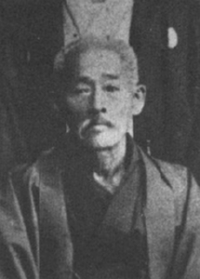 Higaonna (Higashionna) Kanryo (東恩納 寛量)
Higaonna (Higashionna) Kanryo (東恩納 寛量)
Higaonna (Higashionna) Kanryo (Higaonna Kanryō March 10, 1853 – December 1916), also known as „Higashionna West”, was a native of Nishi-shin-machi, Naha, Okinawa. He was born in Nishimura, Naha to a merchant family, whose business was selling firewood, an expensive commodity in the Ryukyu Islands. He founded the fighting style later to be known as Gōjū ryū karate
The characters of his family name are pronounced „Higaonna” in Okinawan, and „Higashionna” in Japanese. In Western articles the two spellings are often used interchangeably. He had an older relative, 5 years older, called Higaonna Kanryu who lived in Higashimura and was known as „Higashionna East”
In 1867 he began to study Monk Fist Boxing (Luohan Quan) from Aragaki Tsuji Pechin Seisho who was a fluent Chinese speaker and interpreter for the Ryukyu court At that time the word karate was not in common use, and the martial arts were often referred to simply as Te („hand”), sometimes prefaced by the area of origin, as Naha-te, Shuri-te, or simply Okinawa-te
.In September 1870, Higaonna was petitioned to go to Beijing as a translator for Okinawan officials. In March 1873 he sailed to Fuzhou in the Fukien province of China.
Aragaki had given Higaonna an introduction to the martial arts master Kojo Taitei whose dojo was in Fuzhou. Higaonna spent his time studying with various teachers of the Chinese martial arts, the first four years he probably studied with Wai Xinxian, Kojo Tatai and or Iwah at the Kojo Dojo. Kanryo then trained under Ru Ru Ko (a.k.a. Ruru Ko, Ryu Ryu Ko, To Ru Ko, or Lu Lu Ko, his name was never recorded as Kanryo Higaonna was illiterate. His real name was probably Xie Zhongxiang founder of Whooping Crane gongfu). According to oral account Kanryo spent years doing household chores for master Ru Ru Ko, until he saved his daughter from drowning during a heavy flood and begged the master to teach Kung-fu as a reward.
In the 1880s Kanryo returned to Okinawa and continued the family business. He also began to teach the martial arts in and around Naha. His style was distinguished by its integration of both go-no (hard) and ju-no (soft) techniques in one system. He became so prominent that the name „Naha-te” became identified with Higaonna Kanryo’s system.
Kanryo was noted for his powerful Sanchin kata, or form. Students reported that the wooden floor would be hot from the gripping of his feet.
Several of Kanryo’s students went on to become influential masters of what came to be called karate, amongst them Chōjun Miyagi, Kenwa Mabuni, Kyoda Shigehatsu, Koki Shiroma, Higa Seiko, and Shiroma Shinpan (Gusukuma)
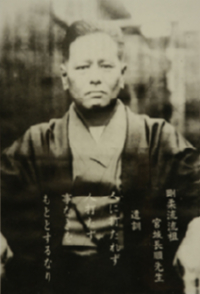 Chōjun Miyagi (宮城 長順)
Chōjun Miyagi (宮城 長順)
Chōjun Miyagi (Miyagi Chōjun April 25, 1888—October 8, 1953) was an Okinawan martial artist who founded the Goju-ryu school of karate
Miyagi was born in Higashimachi, Naha, Okinawa on April 25, 1888, the adopted son of a wealthy businessman. He began his study in Karate-do at the age of nine (or fourteen). He first learned martial arts from Ryuko Aragaki, who then introduced him to Kanryo Higashionna when Miyagi was 14. Under his tutelage, Miyagi underwent a very long and arduous period of training. His training with Higaonna was interrupted for a two-year period while Miyagi completed his military service, 1910-1912, in Miyakonojo, Miyazaki Ken.
In 1915, after the death of Kanryo Higashionna, Miyagi travelled to Fujian Province. In China he studied the Shaolin
and Pa Kua(Ba gua) forms of Chinese boxing. From the blending of these systems, the hard linear/external form of
Shaolin, the soft circular/internal form of Pa Kua, and his native Naha-Te, a new system emerged. However, it was
not until 1929 that Chojun Miyagi named the system Goju-ryu, meaning „hard soft style”.
After some years in China, Chōjun Miyagi returned to Naha where he opened a dojo (training hall). He taught for many years, gaining an enormous reputation as a karateka. Despite his reputation, his greatest achievements lie in popularization and the organization of karate teaching methods. He introduced karate into Okinawa police work, high schools and other fields of society. He revised and further developed Sanchin – the hard aspect of Goju, and created Tensho – the soft aspect. These kata are considered to contain the essence of the Goju-ryu. The highest kata, Suparinpei is said to contain the full syllabus of Goju-ryu. Shisochin was Miyagi’s favorite kata at the end of his years. Tensho was influenced by the White Crane kata Ryokushu, which he learned from his long-time friend Gokenki. With the goal of unification of various karate styles which was in fashion at that time (see Gichin Funakoshi for his works in Japan), he also created more Shurite-like katas Gekisai Dai Ichi and Gekisai Dai Ni in 1940, taking techniques from higher forms (notably Suparinpei, and upper blocks uncommon for Goju-ryu at that time) and incorporating them into a shorter forms. It is said he created these kata to bridge the gap between Sanchin and Saifa, which contains much more complex moves compared to Sanchin. However, Gekisai katas are learned before Sanchin now.
Miyagi died in Okinawa on October 8, 1953 from a second heart-attack (the first had occurred in 1951).
Some of Miyagi’s more notable students were: Seko Higa (his oldest student and also a student of Kanryo Higaonna), Miyazato Ei’ichi (founder of the Jundokan dojo), Meitoku Yagi (founder of the Meibukan dojo, who eventually accepted Miyagi’s gi and obi from Miyagi’s family), Seikichi Toguchi (founder of Shorei-kan Goju-ryu), and on the Japanese mainland Gōgen Yamaguchi who was the founder of the International Karate do Goju Kai Association and who after training with Miyagi, became the representative of Gōjū-ryū in Japan. At a later date Gōgen Yamaguchi invested much time studying Kata under Meitoku Yagi.He also trained other students who went on to create their own styles, such as Shimabuku Tatsuo (Isshinryu).
„Let me first say that I was not named the successor of goju-ryu by Miyagi, but nor was anyone else. There are some goju-ryu teachers who claim to have been privately appointed successor by Miyagi. These claims are ludicrous and disrespectful of his memory. He never publicly named anyone as successor. Common sense would dictate that if he were to appoint someone, it would have been a longtime student and it would have to be of public record to have any value. Miyagi was not a man to do things in a haphazard manner – everything was very deliberate and precise.
It would also be logical to assume that since Miyagi would not grant dan ranking, how then would he be inclined to name a successor? I feel Miyagi would be rolling in his grave with the plethora of ridiculous claims about this matter.” – Seikichi Toguchi
 Nakaima Norisato(Nakaima Kenri)
Nakaima Norisato(Nakaima Kenri)
Ryuei-ryu (劉衛流 Ryūei-ryū) is an Okinawan style of karate. It was originally a family style of the Nakaima family of Naha and is now one of the internationally recognized Okinawan karate styles. It is practiced in the United States, Argentina, Venezuela, Europe, and Okinawa
The originator of the Ryueiryu method was the Okinawan Nakaima Norisato (also known as Kenri). Born December, 1819 into a considerably wealthy family (by the Okinawan standards of the time). He developed a passion for the martial arts at a young age, and was known throughout the village of Kumemura (Kume) as a devoted practitioner of the cultural as well as combative arts.
The area called Kume in Naha was settled by Chinese (often referred to as the „Thirty-six family names”) from Fukien (Fukuken, Fukuken-sho), China about 600 years ago. Being born and brought up in the area under deep influence from China for a long time, Norisato was very familiar with Chinese cultural ways and could speak and communicate freely in at least one dialect of the language.
It is known that the last Satsufu-shi (*Chinese ambassadors) were sent to Okinawa in 1866, In 503 years (from 1372 to 1876 when Japan discontinued the relationship with the King Dynasty) about the same number of military officers as ambassadors were sent to Ryukyu.
Reportedly, when Norisato was 18 years old, he heard that the military officers were practicing martial arts every day and visited the practice area. Since no formal dojo existed during this period, Norisato, interested in martial arts, was watching the practice over the fence. Then one of the officers noticed Norisato and the yuchi (general) eventually noticed the potential and talent of the young Norisato.
With the help of a Chinese military envoy to Okinawa who provided the appropriate letter of introduction and one year of preparation, Nakaima left his native Okinawa for China to study the martial arts. At the age of nineteen, The tall, well built Nakaima was accepted as a disciple of the Chinese Master Ru Ru Ko, who at the time was the lead instructor at the Military Academy in Beijing. Alongside Nakaima was good friend Sakiyama Kitoku, who also left Okinawa to study in China, but reportedly returned to the island after a comparatively short time and was not admitted to the same training.
Norisato originally intended to learn Chinese Martial Arts as a method of personal protection, he became heavily influenced by his teacher gradually studying deeply the military subjects required for Chinese military officers. Subjects ranged from complex military strategies to astrology and holistic healing methods, which are still preserved within the system today.
After seven years of diligent study under the master, Nakaima graduated and was awarded his masters teaching degree at, or around the age of twenty six. At this time he was given some secret books. As customary in China, his instructor only trusted his most dedicated pupil with these guarded texts. Contained in these books was a wealth of information on the civil combative traditions of China. Some of these books* were entitled “Bubishi”, “Hyoronshi”, “Kokutski”, “Kenyushin” and “Yojoho” and are only recently being discovered and appreciated by many of the older and more advanced practitioners of the fighting arts of China and Okinawa throughout the world today. Before he returned to his homeland, Nakaima traveled “for training purposes” throughout the Fukien, Canton and Beijing areas of China. There he saw many unique methods of training and embraced many teachings. Additionally, he collected many weapons from the various areas he visited and incorporated them into his personal system of Chinese boxing. Before leaving China, the customary vow of secrecy was taken by Nakaima, who realizing the tense political climate of the day, never broke this solemn oath
The system that Nakaima devised and learned was taught only to his son Noritada (Kenchu;1856 -1953), but only after making a pledge of secrecy to maintain the great tradition to which he now belonged. Noritada, keeping this oath, only taught his own son Noritaka (Kenko) and grandchildren, who also took the family oath of secrecy. While Nakaima Noritada (Kenchu) had no other students, he was regarded as a master of martial arts by all his contemporaries and was respected by all who knew him.
The young Nakaima Noritaka also developed a keen interest in budo, studying other Karate and kobudo styles as well as kendo under popular instructors. However, it was Nakaima Noritaka was the first family member to break the family tradition and at the age of 60, fearing that the family art would be lost, accepted a small group of outside students. These students were all school teachers, who Nakaima felt “possessed the necessary character, education and background to continue the teachings in the proper manner”. Nakaima did much to assist with the development of many of today’s leaders throughout Okinawa and Japan
According to numerous senior instructors of various styles that were well acquainted with Nakaima Kenko (including Shorinryu leader Nakazato Shugoro), Nakaima reportedly never taught much Ryueiryu to children apart from his own sons, nor owned a dojo, although he often shared the training hall of Nakamura Shigeru and others. Nakaima was well respected in his region and helped with the organization of the Okinawa Kenpo school, and others. A professional educator and of a higher social status than many of his contemporaries, Nakaima held strong convictions regarding the responsibilities of a martial artist and teacher. This unique background and uncompromising standard set Nakaima apart from many islanders that sought the development of martial arts for financial gain in the wake of the Second World War.
Nakaima Kenko was a well respected leader in the Okinawan martial arts community and was a key figure in the growth of several organized movements of the late 1950’s through the 1960’s. He remained an important figure in the development of martial arts on Okinawa until his death in 1989. The current leader of the system is Nakaima Kenji, the 5th generation Soke of the family art and a well accomplished martial arts master in his own right, respected throughout Japan.
Currently, the Nakaima family has disassociated itself from the sport Karate groups and maintains no affiliation, other than supporting the endeavors of previous students of Nakaima. The teachings of the art of Ryueiryu as practiced by the Nakaima family adhere to the code of martial virtue contrasting greatly from the competitive mindset. Karate, as practiced in the Nakaima Family original art is complete physical art form, a wonderful discipline of health as well as a way of life. As such, students of authentic Ryueiryu believe that a real martial artist trained in the tradition should be modest and never brag about his own achievements or proficiency, always keeping in mind the example and directions of our predecessors. A martial artist should be ready to learn from others and strive to learn from every situation in both training and life.
Most written information widely available in the English language about the Ryuei Ryu system is, to a large degree, inaccurate. There are more kata that are contained in the system, various categories of martial strategy and technique, health and wellness practices and other methods that make the system an obviously Chinese based martial arts system, as opposed to a „style” of karate. Adding to the confusion of the published information previously available about the Ryuei Ryu are the writings and video efforts of former world renowned Karate competitor Tsuguo Sakumoto of Japan, both of which only demonstrate a variation of the Karate that he personally learned from Kenko Nakaima, re-arranged for modern sports competition.
Today, legitimate Ryuei Ryu remains a relatively unknown combative system of Chinese origin, with a few of the style’s more unique kata being modified for sports competition. This is largely due to the introduction of the art into the sport karate arena during the mid 1980’s by several of the students of Nakaima Kenko.
The following video from Tsuguo Sakumoto Sensei has no mention of several people who claim to be instructors for the Ryuei Ryu system that are in the US and abroad. Also explains that his Ryuei Ryu is his version, and not the only version.
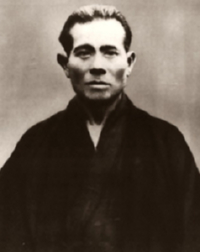 Kanbun Uechi (上地 完文)
Kanbun Uechi (上地 完文)
Kanbun Uechi (Uechi Kanbun, May 5, 1877 – November 25, 1948) was the founder of Uechi-ryū, one of the primary karate styles of Okinawa.
Kanbun grew up in the mountain farming village of Izumi on the Motobu peninsula of Okinawa. Uechi’s family were farmers of daikon radishes.
In his youth, Uechi studied bōjutsu with Motobu experts.
Japan began a program of universal male conscription in Okinawa in the late 1800s. In 1897 at the age of 19, Kanbun fled to Fuzhou in Fukien Province, China both to escape Japanese military conscription and to fulfill his dreams of studying martial arts with Chinese masters.Upon arrival in China, Uechi initially took up the study of Kojo Ryū, but dojo management mocked him for a speech impediment and the offended Uechi sought training elsewhere.
Kanbun Uechi studied Pangai-noon (half-hard, half-soft) under Shushiwa in the Fujian (a.k.a. Fukien) province of mainland China in the late 19th century and early 20th century. After studying 10 years under Shushiwa, Kanbun Uechi opened his own school in the province of Nanjing. Two years later, Kanbun Uechi returned to Okinawa, determined never to teach again because one of his Chinese students had killed a neighbour with an open-hand technique in a dispute over land irrigation. While he was working as a janitor he was persuaded by a co-worker, Ryuyu Tomoyose, to teach again after having been first convinced to show Tomoyose ways of defending himself against different attacks. When his confidence as a teacher was restored, Uechi, with the help of Ryuyu Tomoyose, moved to Wakayama City, Wakayama Prefecture, where, in 1925, he established the Institute of Pangainun-ryū (half-hard half-soft) Todi-jutsu, and opened a dojo to the public. Eventually, in 1940, his Okinawan students renamed the system as „Uechi Ryū”.
Kanbun Uechi’s son, Kanei Uechi, taught the style at the Futenma City Dojo, Okinawa, and was considered the first Okinawan to sanction teaching foreigners. One of Kanbun’s students, Ryuko Tomoyose, taught a young American serviceman named George Mattson who authored several books on the subject and is largely responsible for popularizing the style in America. Uechi Ryū emphasizes toughness of body with quick blows and kicks. Some of the more distinctive weapons of Uechi practitioners are the one-knuckle punch (shoken), spearhand (nukite), and the toe kick (shomen geri). On account of this emphasis on simplicity, stability, and a combination of linear and circular movements, proponents claim the style is more practical for self-defense than most other martial arts.
In contrast to the more linear styles of karate based on Okinawan Shuri-te or Tomari-te, Uechi Ryū’s connection with Chinese Nanpa Shorin-ken means the former shares a similar foundation with Naha-Te (and thus with Goju-ryu) despite their separate development. Thus, Uechi Ryū is also heavily influenced by the circular motions which belong to the kung fu from Fujian province. Uechi Ryū is principally based on the movements of 3 animals: the Tiger, the Dragon, and the Crane
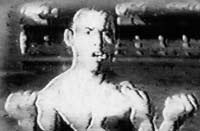 Juhatsu Kyoda (許田 重発)
Juhatsu Kyoda (許田 重発)
Juhatsu Kyoda (Kyoda Juhatsu December 5, 1887–August 31, 1968) entered the dojo of Higaonna Kanryō in 1902 and continued studying with him until Kanryō’s death in 1915. One month after Kyoda started, Miyagi Chōjun (co-founder of Gōjū-ryū) entered the dojo. In 1908, Kenwa Mabuni (founder of Shitō-ryū) also joined the dojo of Higaonna Kanryō.
Tōon-ryū (東恩流 Tōu’on-ryū) is a style of Okinawan Karate founded by Juhatsu Kyoda. In 1934 Kyoda received his Kyoshi license from the Dai Nippon Butoku Kai.
The Tōon-ryū kata and training drills consist of: Ten-I-Happo, Tsuki-Uke (Shiho-Uke), Kiso I & II, Sanchin, Sesan, Sanseru, Pechurin, Jion, & Nepai. Apparently Kyoda knew two versions of Seisan: one from Higaonna Kanryō and one from Higaonna Kanryu, but only passed on the Kanyu version. He learned Jion from Kentsū Yabu. By far Higaonna Kanryō had the most profound impact on him as Kyoda devoted well over a decade of his life to learning Kanryō’s karate. He ultimately named his style after him: Tō-on-ryū (literally ‘Higaon[na] style’).
Kyoda’s tradition was carried on by Iraha Choko, Kyoda Juko (3rd son), and Kanzaki Shigekazu. The current Sōke of Tōon-ryū today is Kanzaki Shigekazu, and the chief instructor is Ikeda Shigenori
Sekō (Seiko) Higa (比嘉 世幸)
Sekō (Seiko) Higa (Higa Sekō November 8, 1898–April 16, 1966) was a Gojū Ryū karate teacher who was born in Naha.
At age 13 he began to study under Higaonna Kanryō until Higaonna’s death 4 years later. He continued his studies with Miyagi Chōjun for 38 years until Miyagi’s death. Among Higa’s students were Choboku Takamine, his son Seikichi Higa (who carried on his father’s dojo in Okinawa), Kanki Izumigawa who spread Goju-Ryu in mainland Japan Kawasaki area, Seiichi Akamine (creator of the Ken-Shin-Kan, spread Karate-do in South America). Seikichi Toguchi (creator of the Shoreikan), Choyu Kiyuna, Seitoku Matayoshi, Seiko Fukuchi (1919-1975), Eiki Kurashita, Zensei Gushiken, Izumi and others that carried on the Goju-ryu Kokusai Karate Kobudo Renmei.
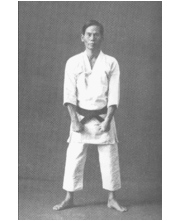 Shinpan Gusukuma (城間 真繁)
Shinpan Gusukuma (城間 真繁)
Shinpan Gusukuma (Shiroma Shinpan,1890–1954), also known as Shinpan Shiroma by the Japanese, was an Okinawan martial artist who studied Shōrin-ryū karate as a student of Ankō Itosu. Gusukuma also trained under Higaonna Kanryō in the Naha-te style. Gusukuma went on to establish Shitō-ryū with Kenwa Mabuni.Gusukuma Shinpan born in 1890 in the town of Tairain Shuri,Okinawa
At the age of thirteen, he began the study of karate with Anko Itosu, and in 1908 he began training with Kanryo Higaonna, along with Kenwa Mabuni. In 1909 at the age of eighteen, Shipan was inducted into the Japanese Navy. He became a school teacher by profession and worked as a professor in the Shuri Dai Ichi Elementary School where he also taught karate. He was also known for his skills as an acupuncturistand taught the art.Shinpan began teaching Shorin-ryu shortly after World War II and was associated with Miyagi Chojun, Kyoda Jyuhatsu and Kyan Chotoku. He taught regularly at Shuri Castle and had a dojo at his home in Nishihara City.
On Okinawa, there were two branches of Shito-Ryu, one founded by Shinpan Shiroma and the other by Kenwa Mabuni. Because he continued to maintain schools only in Okinawa, Shinpan created the only known Okinawan branch of Shitō-ryū. He established an organization called the Shinpan Shiroma Shito-ryu Preservation Society to assist with his teaching and served as president
Shinpan suffered during the Battle of Okinawa and lost many of his students, but after World War II, he reopened his dojo in Shuri.Shinpan died in 1954 at the age of 64. He taught class and trained for two hours on the day of his death, ate a light dinner and went to bed early. Three hours later his wife found that he had died in his sleep. His student Horoku Ishikawa continued his branch of Shito-ryu.
 Gōgen Yamaguchi (山口剛玄)
Gōgen Yamaguchi (山口剛玄)
Gōgen Yamaguchi (Yamaguchi Gōgen; b.20 January 1909 d.20 May 1989. was a world renown Grandmaster of Japanese Karate-dō and founder of the International Karate-dō Gōjū-kai Association; he was one of the most well known of all Karate-dō masters to come out of Japan. Prior to his death he was decorated by the Emperor of Japan in 1968 with the Ranju-Houshou,(translation- Blue Ribbon Medal) and the fifth order of merit, for his enormous contribution to the spread world wide of the Japanese martial arts. For many years Gōgen Yamaguchi was listed in the Guinness Book of Records regarding his rank and achievements. According to his obituary, „His name was a household word in Karate circles, and he appeared in all the major Martial Arts magazines and publications, both in Japan and the western world.”
According to his autobiographical work: Karate Gojū-ryū by the Cat Tokyo, Japan (1963), Gōgen Yamaguchi was born on January 20 in 1909 in Miyakonojō Shonai, Miyazaki Prefecture, Japan, near Kagoshima City on the island of Kyūshū. In his 5th year of primary school Yamaguchi commenced his karate-dō training under the guidance of Takeo Maruta, a carpenter joiner from Okinawa. Maruta was a Gōjū-ryū practitioner.
Gōgen Yamaguchi was named Jitsumi Yamaguchi by his father Tokutarō who was a merchant and later a schoolteacher and superintendent; his mother was Yoshimatsu. Jitsumi was their 3rd son and there were ten children in this very large Japanese family.
Gōgen Yamaguchi was also famously known in the world of karate-dō as ‘the Cat’; he was a very small man, just over five feet and a mere 160 pounds, however he projected the impression of great bulk and an aura reminiscent of the samurai era. He was first dubbed ‘the Cat’ by American GI’s for his gliding walk and flowing hair. He alone was primarily responsible for the spread of Gōjū-ryū throughout the world today whereby hundreds of thousands of practitioners have experienced some form of training within traditional and non-traditional karate dojo[citation required].
According to Gōgen Yamaguchi himself when interviewed by French magazine Karate journalist Rolland Gaillac, April 1977 edition , he stated: „Even today, young man, if you were to face me in combat, I would be able to determine in a second the strength of your Ki. Immediately I would know if you were a good opponent. It is this quality, and no other, which has given me the name of The Cat.”
Gōgen then began the serious study of karate-dō with Sensei Takeo Maruta after his family relocated to Kyoto. Maruta was also a carpenter or joiner by trade and was himself a student of the legendary Chōjun Miyagi of Okinawa. Gōgen Yamaguchi studied directly with Chōjun Miyagi later in 1929, after he and his then-current teacher and friend Jitsuei Yogi wrote to Chōjun Miyagi and invited him to come to Japan.
Chōjun Miyagi visited the university dojo of Kansai, Osaka, Ritsumeikan, Kyoto, and Doshisha Universities, whilst Gōgen was attending Ritsumeikan University in Kyoto. There he studied Law and in 1930 Yogi together with Gōgen Yamaguchi co-founded the Ritsumeikan daigaku karate kenkyū-kailit. Ritsumeikan University Karate Research Association), the first karate club at Ritsumeikan University. The Ritsumeikan Karate-dō Kenkyū-kai was the first university karate club in western Japan and was infamous for its hard style training and fierce karate fighters. Both Yogi and Yamaguchi attended Ritsumeikan University during the time Chōjun Miyagi visited, and Chōjun Miyagi stayed in Yogi’s apartment.
Chōjun Miyagi later gave Gōgen Yamaguchi the responsibility for spreading Gōjū-ryū in mainland Japan. In the early 1930’s Gōgen designed what would become the legendary signature Gōjū-ryū fist. It is said to be modeled after the right hand fist of Chōjun Miyagi.
After graduating from Ritsumeikan University in Kyoto in 1934, that same year Gōgen designed and introduced Jiyū-kumite which has become known today as sport and tournament fighting kumite.In 1935 he officially formed the All Japan Karate-dō Gōjū-kai Karate-dō Association (which later split into the JKF Gojukai and the J.K.G.A.) Also in 1935 Gōgen began his travels with the Japanese government as an intelligence officer and his first son Norimi Gōsei Yamaguchi was born (Gōsei is the current leader of Gōjū-kai USA).
During his military tour in Manchuria in World War II, Gōgen was captured by the Soviet military in 1942 and incarcerated as a prisoner of war in a Russian concentration camp; it was here that he battled and defeated a live tiger according to his autobiography (cited above). Gōgen Yamaguchi was originally targeted for hard labour in the POW camp however he had impressed even these hard nosed Russians and who discovered who he was and requested that he teach karate-dō to the Russian soldiers, it was then that, ‘the prisoner became the master of the guards, who became his students’.
In 1945, Gōgen returned to Japan where he re-opened his initial karate-dō dojo in Nippori which was later destroyed by fire, and advertised with a sign outside reading Gōjū-ryū-kai. Many people thought his school was closed forever and that he had been killed in the war; accordingly Gōgen held large exhibitions in Tokyo which showcased the various Chinese and Japanese martial arts that he had experienced. His school reopened and moved at a later date to the Suginami-ku area of Tokyo. Here he quickly expanded throughout a network of independent Gōjū-ryū dojo. The rapid growth and expansion was reinforced by Gōgen’s energetic and forceful persona which resulted in a worldwide network of karate schools which he alone built into a powerful martial arts empire.
Mention must be made here of Gōgen Yamaguchi’s legendary discussion noted in his autobiography regarding his military duty in Manchuria during World War II, whereby Gōgen was a prisoner of War of the Soviet Army in 1942 and incarcerated at a Russian concentration camp; it was here that he admitted having battled and defeated a live tiger, after he was locked in a cell with the beast which his captors expected would devour him. Certainly this admission has created much controversy, however Russian sources from the time would need to be located in order to verify the extent of the veracity of this event.
Gōgen Yamaguchi established the Gōjū-kai Headquarters in Suginami-ku, Tokyo, Japan, nearby to the busy shopping precinct of Roppongi. It was also at this time that he registered the name Gōjū-ryū formally with the Butoku-kai, (the official government body and Headquarters for the Japanese Martial Arts). By 1950 Gōjū-kai Headquarters was officially relocated to the Suginami Tokyo school which contributed to an almost tripling of membership to 450,000 according to his autobiography. Five years later he officially chartered the I.K.G.A. Later in 1964, Gōgen Yamaguchi along with other founder members Ōtsuka Hironori from Wadō-ryū; Nakayama Masatoshi from Shotokan; Mabuni Kenei and Iwata Manzao of Shitō-ryū, unified all the karate dojo in Japan to form the All Japan Karate-dō Federation which is still in existence today as the Japan Karate Federation (JKF).Gōgen Yamaguchi’s contributions to Gōjū-ryū karate-dō and to karate-dō in general have been enormous. Under his leadership and guidance the International Karate-dō Gōjū-kai Association (I.K.G.A) has developed and thrived. The organization has increased in popularity both in Japan and other Asian and Western countries throughout the world. By 2008 there were approximately 60-70 countries teaching the Gōjū-kai karate-dō principles and training methods. Gōgen Yamaguchi succeeded in unifying all the karate schools in Japan into a single union which resulted in the formation of The Federation of All Japan Karate-dō Organization (F.A.J.K.O.) in 1964. The Kokusai Budō Renmei – (The International Martial Arts Federation) in Japan, whose chairman was Prince Higashikuni of the Japanese Imperial Family appointed Master Yamaguchi as a Shihan – Master of that organisation’s karate-dō division. Yamaguchi added to the Gōjū system the Taikyoku kata forms, – training methods for the beginner students to prepare them for the more advanced kata.
Gōgen Yamaguchi Kaiso died on the 20th of May 1989. He had been married twice, firstly to Midori (who still lives on the island of Kyushu), with whom he had four children: Gōsei Norimi Yamaguchi (b.1935), Gōsen Kishio Yamaguchi (1940-1990), Makiko Yamaguchi, and Gōshi Hirofumi Yamaguchi (b.1942). He and his second wife, Mitsue, had one child, Gōkyōko Wakako Yamaguchi. All of his children practiced karate-dō and became Masters in their own right. The names commencing with gō were their karate names. Gōsei Norimi Yamaguchi has his own organisation in the United States and Gōshi Hirofumi Yamaguchi is the President of the International Karate-dō Gōjū-kai, with branches in 60 countries. Gōsen Kishio Yamaguchi was the Vice President of Japan Airlines. Kishio, who died in the early 1990s, was deeply involved in the running of the I.K.G.A whilst his youngest sister Wakako Yamaguchi was an All Japan Kata Champion for a number of years. Makiko Yamaguchi died from cancer at a relatively young age during the early 1980s
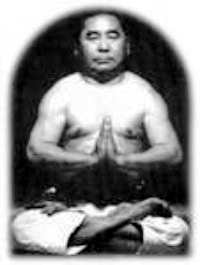 Seikichi Toguchi
Seikichi Toguchi
Seikichi Toguchi (b. May 20, 1917 in Naha City, Okinawa, Japan – d. August 31, 1998 in Tokyo) was the founder of Shorei-kan karate.
As a young boy, Toguchi learned the basic techniques of Okinawan Te from his father. In 1930, at the age of 15, he began his lifelong study of Gōjū-ryū karate at the dojo of Sekō Higa and later under Chojun Miyagi as one of his principal students. He studied under Higa for over 33 years and under Miyagi for more than 25 years, making his karate education unique. Toguchi was fortunate as Miyagi was a personal friend of Toguchi’s father and so paid many visits to the family. At these times the conversation nearly always turned to karate and the discussions would go on till the early hours of the morning.
Toguchi continued his full-time study of karate until the beginning of World War II, when he was drafted into the army as an electrical engineer and stationed in Sumatra, Indonesia.
In 1946 he returned to Okinawa to find a devastated people and homeland. Miyagi had lost three children and one of his senior students, Jinan Shinsato. Higa had lost his wife. Miyagi began teaching at the police academy and Higa moved in with Toguchi. At this time Higa also played matchmaker and introduced Toguchi to a young girl named Haruko, soon to be his wife.
In 1949, with the help of Toguchi, Higa opened up a new dojo and Toguchi was appointed Shihan. Before his death, Miyagi passed on all his advanced kata and teachings to Toguchi, one of the more important being kaisai no genri. This teaching explains how to unlock the hidden techniques of the koryu kata. In 1953, after the death of Miyagi, his senior students formed the Karate-Do Goju Association with Meitoku Yagi as chairman and Seikichi Toguchi as Vice Chairman.
In 1954 Toguchi opened up the first Shorei-kan dojo (House of politeness and respect) in Koza City, Okinawa. The Shorei-kan dojo was very close to the American military base (Kadena Air Base) and the Americans showed a great interest in the martial arts. With an increasing western population in his dojo, Toguchi found it necessary to devise a progressive teaching method to overcome the language barrier. Expanding on Miyagi’s vision, Toguchi further developed a system of progressive kata and added bunkai and kiso kumite to help explain application of the kata. Many of the early pioneers of Okinawan karate in the US studied with Toguchi.
In 1956 the Okinawan Karate-Do Federation was formed and Toguchi was installed as a member of the board of directors. By 1960 Toguchi decided to move to mainland Japan to spread the art of karate and Shorei-kan. During the coming years he would move between Okinawa in the winter and Tokyo in the summer. He first practiced outdoors at the Hikawa Shrine where he developed the kata Hakitsuru. In 1962 the first Shorei-kan dojo was opened in Tokyo in Meguro Borough and in 1966 Shorei-kan Hombu Dojo Tokyo was built with the help of Tamano Construction (founded by Toshio Tamano’s father).
Although there were Shorei-kan students and instructors already in the US, in 1969 Toguchi sent Toshio Tamano to the US as the representative of Shorei-kan, and in 1972 Tomaki Koyabu was sent to Canada to spread Shorei-kan Karate. Over the following years Toguchi and his wife Haruko Toguchi traveled numerous times to both Canada and the US. Later on Tamano moved to Milan, Italy to spread Shorei-kan throughout Europe and Scott Lenzi is now the representative of the U.S. and South America. The representative of Canada is now Vic Hargitt and Haribabu represents Asia and Vahitha Haribabu represents India. Haribabu was the last person to receive the shihan title from Toguchi
 Meitoku Yagi (八木明徳)
Meitoku Yagi (八木明徳)
Meitoku Yagi (八木明徳 Yagi Meitoku, March 6, 1912 – February 7, 2003) was born in Naha, Okinawa. Yagi learned Goju-ryu from its legendary founder Chojun Miyagi.
Yagi’s lineage can be traced back to 36 Chinese families that immigrated to Okinawa in 1392. Also, his family can be linked to Jayana Ueekata, who was highly respected as a budoka in the Ryukyu Islands in the 17th century. Yagi is the 21st generation from that family.
Yagi began training under Miyagi when he was 14 years old. Miyagi was impressed by his dedication and hard work, and eventually taught him all the kata in the Goju-ryu syllabus. Normally, Miyagi would only teach Sanchin to his pupils for several years, and even then he might only teach them Seisan and Seiunchin
After Miyagi’s death in 1953, Yagi opened his own dojo in the Daido district of Naha. He named his school of Goju-ryu Meibukan, meaning „house of the pure minded warrior.” The name and crest of his school both utilise the first kanji in his name, Mei, which has several meanings, including purity. It is made up of the kanji for sun and the kanji for moon, reflecting the duality of nature, which is inherent to Goju-ryu. Today, the main headquarters for the Meibukan school are in the Kume district of Naha.On April 29, 1986, Emperor Hirohito named Yagi a Living National Treasure (ningen kokuho) for his contributions to the martial arts.To complement his karate training, Yagi enjoyed many activities including shodo, playing the piano and shamisen, and chinese chess.
Meitoku Yagi began developing a series of kata in the 1970s and 1980s, which he named Meibuken kata. The first of which is Tenchi, meaning „heaven and earth.” It was originally two kata, Fukyu kata ichi and Fukyu kata ni. The two kata can be put together so that if two karateka were to perform each half an attack in the first kata would correspond with a block in the second, for example. The Meibuken kata are different from the kata in the Goju-ryu syllabus in many ways, including having vertical closed hand chambers, and having a different yoi position, reflecting Yagi Sensei’s Chinese roots, and his time spent studying martial arts there.
The other four Meibuken kata represent the four guardians of the cardinal directions in Chinese mythology. As with Ten no kata and Chi no kata, the other four pair up as well to show the kata’s bunkai. Seiryu (East, Blue Dragon) and Byakko (West, White Tiger) go together, and Shujakku (South, Red Phoenix) and Genbu (North, Black Tortoise) combine. Though those are the English names generally used for the kata, Yagi Sensei once said that he never specifically chose colours for the animals.
Yagi has three daughters, Chieko, Chikako and Chizuko; and two sons, Meitatsu and Meitetsu. His sons’ birthdates are unique in that the day and month of their births are the same–Yagi Meitatsu was born July 7, 1944 and Yagi Meitetsu was born January 1, 1949. Currently Yagi Meitatsu is the president of the IMGKA (International Meibukan Goju-ryu Karate Association), and Yagi Meitetsu is the president of the Meibukan hombu dojo. In 1997 Yagi promoted his eldest son, Meitatsu to Hanshi Judan. Before his death, Yagi also promoted Meitetsu to Hanshi Judan in 2001, but it was only made known publicly posthumously.
In 2000, Yagi released an autobiography entitled The Life Drama of the Man, Meitoku.Yagi’s number one goal was for his students to promote peace, be good people and contribute to society.In late 2002, he was 91 and still performing demonstrations of katas. February 7, 2003 at 11:40 am, Dai Sensei Meitoku Yagi died. At the time of his passing he was considered as the most senior Karateka in the world.
Meitatsu Yagi, born July 7, 1944, is the eldest son of the late Meitoku Yagi. Meitatsu did not read books or watch training videos to gain his expertise in Karate. He was being tutored directly by the himself. By training under his his father for over fifty years, he was groomed and trained to carry on the legacy of Meibukan Gojyu-Ryu Karate. One of Yagi’s goals has been to spread Meibukan Gojyu-Ryu Karate throughout the world. Yagi has lived, worked, initiated new dojos and taught Meibukan in several places outside of Okinawa and around the world. Yagi lived in the US from 1964 to 1970; in Guam 1971 to 1975; in Saipan 1995 to 1997 and in the Philippines 1997 to 1998. After returning from Guam in 1975, Yagi was given the title of Renshi 6th Dan and became a Director of All Okinawan Karate-Do Association in 1976. Also in 1976, he was given the teaching responsibilities at the Hombu Dojo in Okinawa as President of Gojyu-Ryu Meibu-kai with Meitetsu Yagi (his younger brother) as Vice-President and Meitoku Yagi as Chairman / Consultant.
Meitoku Yagi chose his eldest son Meitatsu to be the first to learn all facets of Meibukan Gojyu-Ryu. He helped develop and teach all the kata, Renzoku Kumite, Kakomi Kumite, Meibukan Bo, Meibukan Sai, Nihon Kumite, Renzoku form and Kakomi forms. Although many profess to be Meibukan practitioners, many have not learned or practiced the forms developed by him for his style. These forms are an integral part of Meibukan Gojyu-Ryu.Meitatsu was also a director of the All Okinawa Karate-Do Gojyu-Kai for 20 years. He also served a two year term as President of the Okinawan Karate-Do Gojyu-Kai in 1987 as well as President of the Hombu Dojo in Kume.
In 1995 Meitatsu worked in Saipan and the Philippines returning in 1998 to help care for his father who was ailing at the time. Meitoku YAGI gave Meitatsu Yagi the title of Hanshi Judan, Okinawa Karate-Do Gojyu-Kai in 1997. Meitoku Yagi]] presented only one Hanshi Judan]]. Meitatsu Yagi travels the world meeting and teaching hundreds of people each year in seminars in India, Canada, Israel, Italy, the USA, England and France as well as South America]].Meitatsu has also been very active in promoting the Okinawa Traditional Karatedo Kobudo International Studying Center in Yomitan Village, Okinawa. He is working with Kenyu CHINEN of Shorin-Ryu and Yasuo SHIMOJI of Uechi Ryu. All three masters are traditional Okinawan teachers and are working together to promote Okinawa Traditional Karate-Do and Kobudo in Okinawa and around the world.In 2007, he published his second book on the history and philosophy of Meibukan gojyu-ryu, entitled, „Importance of Spiritual Karate”.
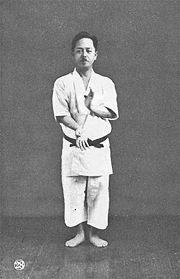 Kenwa Mabuni
Kenwa Mabuni
Born in Shuri on Okinawa in 1889, Mabuni Sensei was a descendant of the famous Onigusukini Samurai family. Perhaps because of his weak constitution, he began his instruction in his home town in the art of Shuri-Te at the age of 13, under the tutelage of the legendary Ankō Itosu (1813-1915). He trained diligently for several years, learning many kata from this great master. It was Itosu who first developed the Pinan kata, which were most probably derived from the ‘Kusanku’ form.
One of his close friends, Sensei Chōjun Miyagi (founder of Gōjū-ryū) introduced Mabuni to another great of that period, Sensei Higaonna Kanryōand began to learn Naha-Te under him as well. While both Itosu and Higashionna taught a ‘hard-soft’ style of Okinawan ‘Te’, their methods and emphases were quite distinct: the Itosu syllabus included straight and powerful techniques as exemplified in the Naifanchi and Bassai kata; the Higashionna syllabus, on the other hand, stressed circular motion and shorter fighting methods as seen in the popular Seipai and Kururunfa forms. Shitō-ryū focuses on both hard and soft techniques to this day.Although he remained true to the teachings of these two great masters, Mabuni sought instruction from a number of other teachers; including Seishō Aragaki, Tawada Shimboku, Sueyoshi Jino and Wu Xianhui (a Chinese master known as Go-Kenki). In fact, Mabuni was legendary for his encyclopaedic knowledge of kata and their bunkai applications.
By the 1920s, he was regarded as the foremost authority on Okinawan kata and their history and was much sought after as a teacher by his contemporaries. There is even some evidence that his expertise was sought out in China, as well as Okinawa and mainland Japan. As a police officer, he taught local law enforcement officers and at the behest of his teacher Itosu, began instruction in the various grammar schools in Shuri and Naha.
